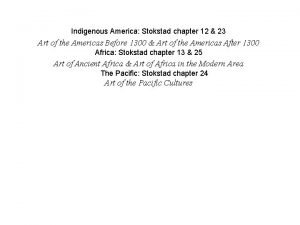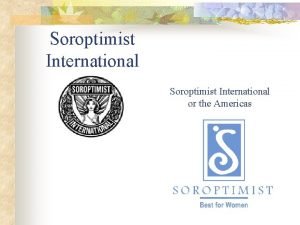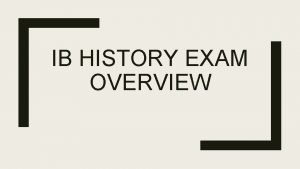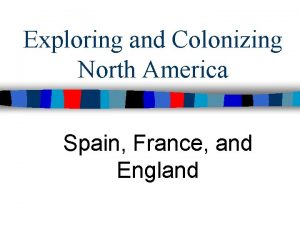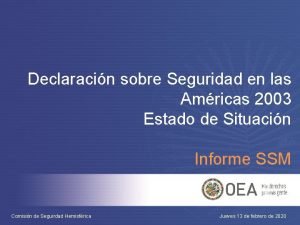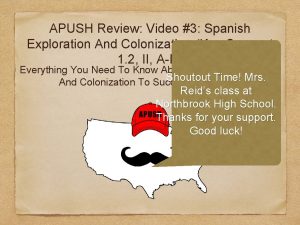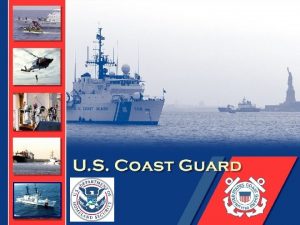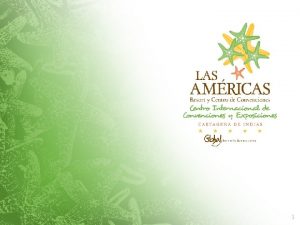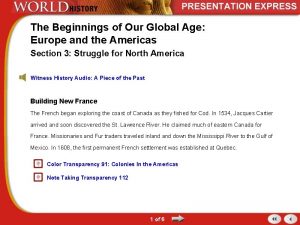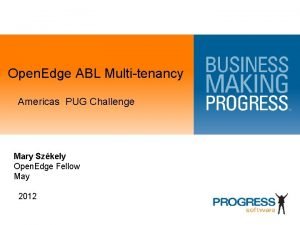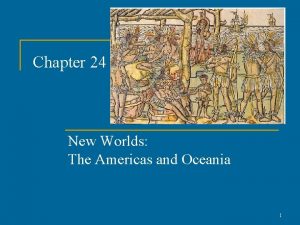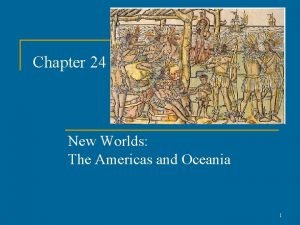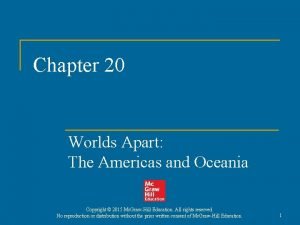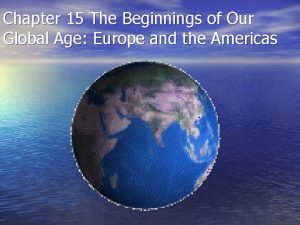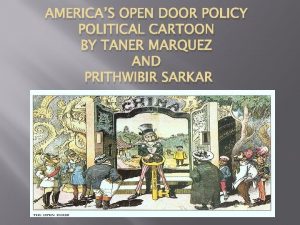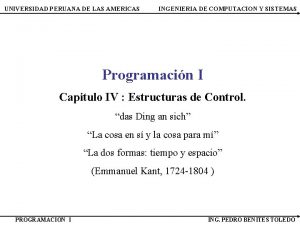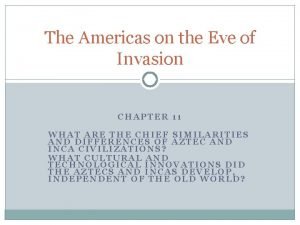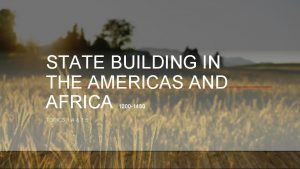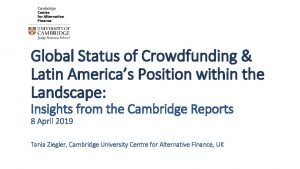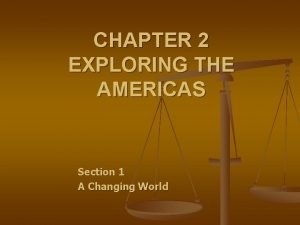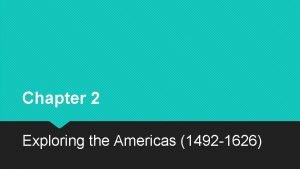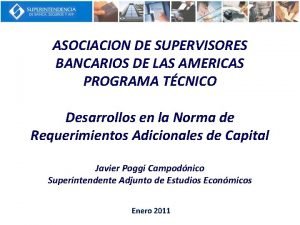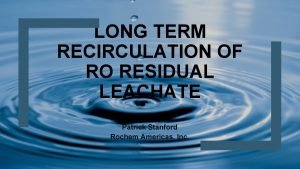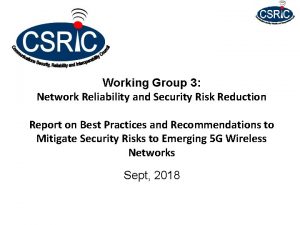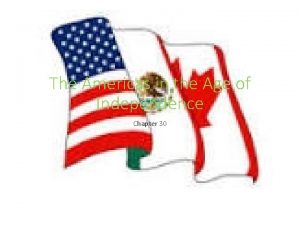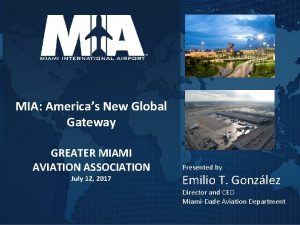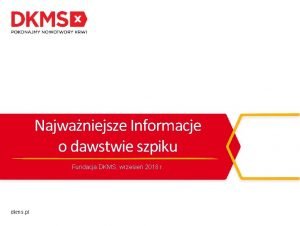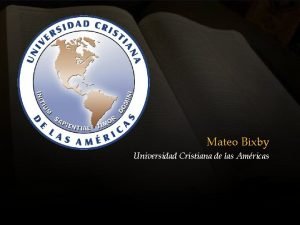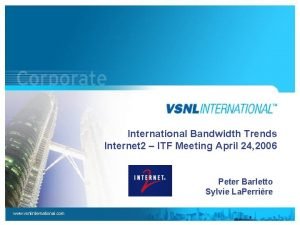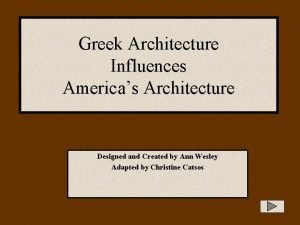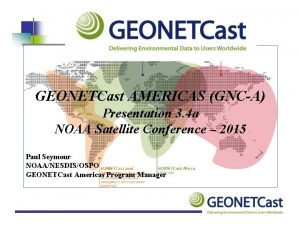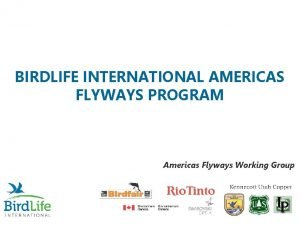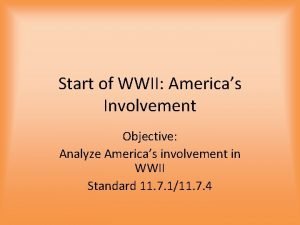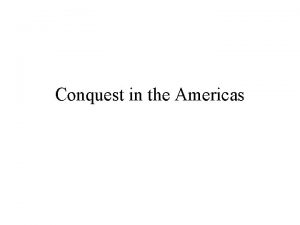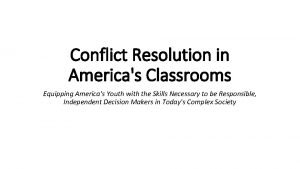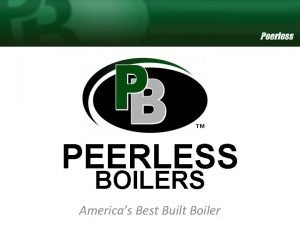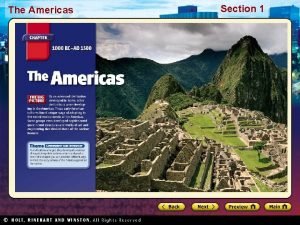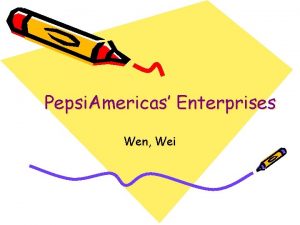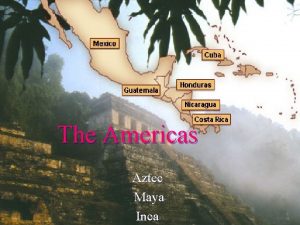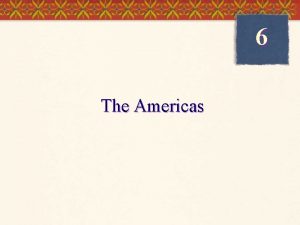ART Program Overview Americas US Program overview ART







































- Slides: 39

ART Program Overview Americas US Program overview ART Program Goals GDE Role ART Management/Strategy ART Program – snapshot Highlights Trends Issues Program beyond 2012 Conclusions Mike Harrison DOE/NSF ART Review June 2010 Slide 1

Particle Physics Project Prioritization Panel (P 5) – US Strategic 10 year plan, June 2008 Americas “Whatever the technology of the future linear collider, and wherever it may be located, the US should plan to play a major role. For the next few years the US should continue to participate in the international R&D program for the ILC. This R&D will position the US for an important role should the ILC be the choice of the international community” • “The panel recommends for the near future a broad accelerator R&D program for lepton colliders that includes continued R&D on the ILC at roughly the proposed FY 2009 level in support of the international effort” This is about as close to a mission statement that ART possesses. On the basis of this recommendation the ART budget for FY 09 -> FY 12 at $35 M/yr. Mike Harrison DOE/NSF ART Review June 2010 Slide 2

ART Program Strategy Americas • The US ART program is designed to: 1. Support the Global Design Effort (GDE) goals (international collaboration) 2. Position the US optimally to make contributions consistent with the US HEP community priorities (future program) 3. Consistent and synergistic with our US lab plans & programs (intrinsic merit) Not what one would term a completely crisp or consistent set of criteria. More like a virtual lab rather than a ‘project’. The ART program is integrated into the GDE Technical Design Phase which runs until 2012 and has the goal of Project Proposal. Mike Harrison DOE/NSF ART Review June 2010 Slide 3

GDE Program themes Americas Industrialisation in-kind contribution models Site requirements Project Schedule Remaining Technical activities Project Implementation Mike Harrison Plan DOE/NSF ART Review June 2010 SCRF Technology R&D (General) AD&I (CFS) ains Rem case ial spec • Regional expertise, global Industrialisation • Average accelerating gradient • Cost (cryomodule, mass-production models) • Sources • DR (e-cloud) • BDS / MDI • Consolidation of baseline(s) • Design choices (parameters, layout etc. ) • Design work (documentation) Cost & Schedule • ICET (schedule tool) • Traceable, defendable • Justification TDR Risk • R&D (and engineering) beyond 2012 • Impact (design, cost, schedule) • Mitigation (fall-back solutions) >2012

ILC Baseline Design - Evolves Americas 250 Gev e+ e- Linear Collider Energy 250 Gev x 250 Gev Length 11 + 11 km # of RF units 560 # of cryomodules 1680 # of 9 -cell cavities 14560 2 Detectors push-pull 2 e 34 peak luminosity 5 Hz rep rate, 1000 -> 6000 bunches per cycle IP spots sizes: sx 350 – 620 nm; sy 3. 5 – 9. 0 nm Mike Harrison DOE/NSF ART Review June 2010 Slide 5

GDE Global Organisation Americas PAC ILCSC FALC Directors Office = Central Office = Executive Committee DIRECTOR AAP Regional Directors SCRF – Main Linac Americas Asia Europe Mike Harrison DOE/NSF ART Review June 2010 Project Managers CFS - Global Systems FALC - RG Experts Accelerator Systems ILC Communications Physics & Detector Communications Project Management • Cost and Schedule • EDMS • Machine Integration • XFEL, Project X liaisons

Americas Rong. Li Geng (JLAB) • Engineering and Scientific Management – 7 Asia – 6 EU – 11 Americas Susanna Guiducci (INFN) GDE Technical Management Mike Harrison DOE/NSF ART Review June 2010 US plays a significant role in the GDE management 081209

GDE Technical Management Americas Mike Harrison DOE/NSF ART Review June 2010 US plays a significant role in the GDE management 081209

ART Program contributions to the GDE Americas The US ART program contains: High gradient cavity development (JLAB/Fermilab/Cornell/ANL) Cryomodule design and fabrication (Fermilab) HLRF (SLAC) Electron cloud/high brightness experimental program (Cornell +………) Beam Delivery system design (SLAC) Final focus & MDI (BNL, SLAC) RTML (Fermilab) Positron production (ANL, LLNL) Electron source development (SLAC, JLAB) Beam Test Facilities ATF 2, FLASH (SLAC, ANL) Conventional Facilities (Fermilab) All elements of the program have well defined deliverables for 2012. Mike Harrison DOE/NSF ART Review June 2010 Slide 9

US ART Program – SRF technology Americas • • • Cavities – Fermilab, ANL, JLAB, Cornell Cryomodules – Fermilab HLRF Systems – SLAC LLRF Systems – Fermilab, ANL, SLAC The SRF technology development is about 50% of the total ART program through 2012 Mike Harrison DOE/NSF ART Review June 2010

ART SRF R&D Program Deliverables (2012) Americas The highest priority activity in the ART program is SRF development which represents 50% of the total effort. In collaboration with Fermilab Project X, the deliverables are: • • • High gradient cavity fabrication (35 MV/m, yield 80%) tech transfer to at least 2 North American vendors completed Cryomodule type 4 design, fabrication and horizontal testing completed for 3 cryomodules Marx modulator, tunable power distribution system LLRF control String test of a complete, high gradient, RF unit; installed ILC RF Unit: 3 CM, klystron, modulator, LLRF Mike Harrison DOE/NSF ART Review June 2010 Slide 11

The ART Program – Management Americas There is no ART organisation chart per sec, we are matrixed into the national labs. The ART management team: SLAC: Fermilab: JLAB: ANL: LBNL: LLNL: Cornell: Mike Harrison DOE/NSF ART Review June 2010 Nan Phinney Bob Kephart Bob Rimmer Rod Gerig John Corlett Brett Parker Jeff Gronberg Mark Palmer Slide 12

ART Management Process Americas • Annual program scope documented at the lab level together with milestones at the beginning of the fiscal year i. e. goals for this year. This is in the context of a multi-year US R&D plan. The detailed program is determined on an annual basis. • SRF Cavity program co-ordinated nationally (Mark Champion) • Monthly (ish) conference calls with the national lab senior managers • ART Face-to-Face meetings at the GDE bi-annual meetings • Labs visits by ART management (MH) + Marc Ross when possible. These discussions are both technical and management. Fermilab (ANL) – monthly, SLAC – quarterly, JLAB – biannual, BNL - monthly, Cornell – biannual. TRIUMF – annually. • Weekly GDE Executive Committee conference calls. EC face-to-face meeting every few months • Bi-annual reports from the labs • Germantown meetings every ~ 2 months with OHEP, NSF briefings bi-annual. Mike Harrison DOE/NSF ART Review June 2010 Slide 13

ART FY 09 Program Milestones Final Americas Mike Harrison DOE/NSF ART Review June 2010

ART FY 10 Program Milestones Americas Mike Harrison DOE/NSF ART Review June 2010

ART DOE FY 11 proposed Funding by System ($35 M) Americas Program Element $M % GDE & Lab Management 4. 26 12. 1 Electron & Positron Source 2. 09 6. 0 Damping Rings 2. 35 6. 7 Beam Delivery 4. 10 11. 7 Accelerator Physics 1. 69 4. 8 Global systems 1. 23 3. 5 RF Technology (SRF + systems) 15. 70 44. 8 Conventional Facilities 1. 46 4. 2 Contingency 2. 19 6. 3 Nominally ~ 95 FTE’s Mike Harrison DOE/NSF ART Review June 2010

ART FY 11 Allocations - from $35. 0 M total Americas Institution $M SLAC 10. 32 Fermilab 11. 55 JLAB 2. 15 BNL 2. 1 Argonne 1. 4 LLNL 0. 8 LBL 0. 4 Cornell 2. 35 + ~ 5 (NSF) GDE (mostly at Fermilab) 1. 9 I have the detailed budgets for FY 10 if useful to the committee Mike Harrison DOE/NSF ART Review June 2010

FY 10 – Highlights Americas • Budget arrived on time and at the agreed upon level ($35 M). Thank you agencies. • Cavities • – The first US cavity manufacturer is well established and we are working on number #2. Significant progress is in gradient is evident. Cavity yield is also improving. Starting to look at repair possibilities (yield of 100% ? ? ) Dressed cavities – The first two attempts had issues but the underlying experience is very positive. We can dress a cavity in a week. We have also shown that there is no systematic gradient degradation in the dressing process Mike Harrison DOE/NSF ART Review June 2010

FY 10 – Highlights Americas • • • CESR TA (Cornell) – The CESR TA e-cloud/brightness program is on track to finish on time and also appears (to me at least) that mitigation techniques are promising. The program is evolving to analize (and incorporate into the baseline) the results and launch a smaller follow on experimental program (NSF supported) ATF 2 (Beam Delivery system @ KEK) – Many interesting results from ATF 2 FLASH (SRF @ DESY) – ILC-like beam in ILC-like cryomodules Mike Harrison DOE/NSF ART Review June 2010

Program Trends Americas • Sheet Beam Klystron development program: reviewed and cancelled in April 2010 • CESR TA will ramp down in FY 11 as the program evolves • HLRF distribution system R&D based on the klystron cluster scheme launched in FY 10 • Increased support for positron production R&D • Increased support for cavity/cryomodule value engineering and gradient/yield in FY 11 • Increased emphasis on the machine-detector interface Mike Harrison DOE/NSF ART Review June 2010

The ART Program – Issues Americas • Andrei Seryi, who has led both the US and the GDE beam delivery system program throughout the ILC R&D phase is leaving to head the John Adams Institute in the UK. We will split the ART effort into the machine detector interface (Tom Markiewicz – SLAC), ATF 2 (Glen White – SLAC), final focus & IP design (Brett Parker – BNL). These efforts will continue to be co- ordinated through the GDE. • Evolution of the CESR TA program in a way to capture the R&D results into the ILC baseline design, write up the data, as well as support the reduced experimental program. • Cavity yield: • ATF 2 SC quad upgrade – will KEK operate the facility after JFY 12 ? Requires nontrivial funding in FY 11 before we will know about KEK plans for ATF 2 • Increased resources for push-pull work – a formal request from BDS/MDI • Project Ambiguity: The ILC remains an unapproved project with an uncertain timeline. How do we proceed after the R&D program ends Mike Harrison DOE/NSF ART Review June 2010 Gradient is demonstrated but 90% yield ?

GDE ILC Timeline (circa 2008) Americas 2005 2006 2007 2008 2009 2010 2011 2012 2013 Reference Design Report (RDR) GDE process Tech. Design Phase (TDP) 1 TDP 2 LHC physics Ready for Project Submission Mike Harrison DOE/NSF ART Review June 2010

The View from ATLAS on physics requirements Americas • Precision EW and top measurements • Search for SUSY at > 1 Te. V after a few fb-1 at 14 Te. V • Standard Model Higgs: Exclude with 2 fb-1 at 14 Te. V 5 s Discovery with ~20 fb-1 in full mass range ( MH>115 Ge. V) • Z’, graviton with early data – Up to to 3. 5 Te. V with 10 fb-1 • Compositeness, Vector-Boson scattering at high L. • LHC lifetime goal remains high – 250 -300 fb-1/year, total L=3000 fb-1 by 2030 – Fully explore the energy frontier, SUSY, extra dim, Z’, W’… Mike Harrison DOE/NSF ART Review June 2010

Estimated LHC performance – (Chamonix 2010) Americas beta energy Months Year n 2012: splice consolidation (and DS collimator prep (? )) n 2013: 6. 5 Te. V ~25% nominal intensity n 2014: 7. 0 Te. V ~40% nominal intensity ib nb Lumi per month Peak Lumi Int Lumi Year Int Lumi Cum. 2010 8 3. 5 2. 5 7 e 10 796 1. 4 e 32 - 0. 1 2011 9 3. 5 2. 5 7 e 10 796 1. 4 e 32 0. 1 0. 9 1. 0 2013 6 6. 5 1 1 e 11 720 1. 2 e 33 0. 9 5. 4 7 2014 7 7 1 1 e 11 1404 2. 3 e 33 1. 8 13 20 2012 Mike Harrison DOE/NSF ART Review June 2010 Optimistic— Pessimistic down by Factor of two 24 Luminosity estimates

ILC possible timeline Americas 2010 CY 2011 2012 2013 2014 2015 2016 2017 2018 Baseline established Technical Design Report complete. Decision to proceed TDR reviews ILC Technical design & R&D program Cost Estimating Site EOI’s SRF system tests Project Implementation Plan complete Physics Run 1 LHC Mike Harrison DOE/NSF ART Review June 2010 Interconnect repair Existence of lowlying SUSY known Site/host established XFEL operation Physics Run 2 Higgs energy scale known -10 -

Why 2012 ? – The Accelerator Advisory Panel, Americas Feb 2010 • The AAP points to uncertainties beyond 2012 in their conclusions: – “Some aspects of the R&D for the ILC will have to continue beyond 2012. ” – “The milestone 2012 is however timely placed. The LHC will be providing operating experience of a large facility and with some luck the first physics discoveries will emerge. ” – “The HEP community is thus well prepared for the decision for the next facility. In a sense the construction of the ILC seems the natural evolution of that process, in which case the efforts for the ILC have to be ramped up without delay. ” – “Nature may be less kind or science policy makers not ready for a decision on the next big HEP project. In this case the large community must be engaged to facilitate the decision for the construction of the next HEP project. ” • We need to prepare for uncertainties in the path to the ILC after 2012, including what LHC tells us. Mike Harrison DOE/NSF ART Review June 2010 26 13 -May-10 PAC - Valencia, Spain

The US ILC Program– Post 2012 Americas The goal of the US ILC program immediately following the end of the global R&D phase in 2012 is to “position US to be a significant partner at ~ 10 -20% level in a global off-shore ILC, should it go forward. ” The decision to proceed with the ILC as a construction project is assumed to be made at some point in the medium-term future, after the submission of the technical design report and the associated cost estimate at the end of 2012. US activities during this period should be built on the current R&D program and start to prepare for possible US contributions to a construction project The assumed timeline is: • 2012 – TDR + cost estimate submitted to ‘FALC’ (CY 12), SRF string test assembled at Fermilab. Concludes the 5 -year R&D program. • 2013 – project proposal reviewed, string test operation • 2014/15 - potential US role established, “FALC” recommends project decision, CD 0 required for DOE participation. (“FALC” – potential collaborating countries) Mike Harrison DOE/NSF ART Review June 2010

The US ILC Program – possible US contributions to a construction project Americas Any US contribution will, at present, require cavities as a major element since globally the number of qualified vendors is small and all qualified production will be needed to meet the ILC volume. Although the situation with respect to cryomodules is less well developed at this point in time a similar logic would seem to apply in regard to US expertise and the needed number of cryomodules. 33% of the cryomodule costs, which includes cavities, is currently 7. 5% of the total value estimate by the GDE. At this time we assume that 2/3 of a US contribution would be SRF related covering at least 33% of the cryomodules. The remaining 1/3 would cover sources, damping rings and the machine/detector interface. The post 2012 program would be formulated to support this concept. A significant element of the program will involve value engineering to be performed with US industry. Particularly cavities, cryomodules and RF systems. Full industrialisation of components at the scale required for the ILC will not be possible until some form of project approval is forthcoming. Until that point the process is better described as technology transfer and production engineering. This will prepare US industry for US contributions. Project X currently intends to cease 1. 3 GHz R&D cavity production. Mike Harrison DOE/NSF ART Review June 2010

The US ILC Program– Program elements post 2012 Americas As the TDR phase and the associated R&D program concludes then the technical elements of the program will be drastically curtailed (CESR TA, electron source, HLRF, LLRF, cryomodule design, BDS design. We will switch to operating the systems test facilities that were fabricated as part of the R&D program e. g. NML. The Fermilab SRF string test will be commissioned in 2012 but the regular facility operations will not start until FY 13. We will continue to support beam delivery system development at the KEK test beam facility (ATF 2). This of course is contingent on KEK deciding to continue to support ATF program past the currently approved JFY 12. We will support a core team to maintain US corporate knowledge and be available for TDR reviews We plan to keep the US SRF industrial base active at a minimally useful level (~12 cavities per year, 1 cryomodule per year). Mike Harrison DOE/NSF ART Review June 2010

The US ILC Program– Program elements post 2012 Americas It’s likely that positron production will benefit from R&D past 2012. It is likely that machine-detector interface activities will need to continue. This will help to facilitate the detector program. Mike Harrison DOE/NSF ART Review June 2010

The ART Program - 2013 Americas Likely activities in 2013 involve: • • Operation of the Fermilab SRF string w/o beam (33% duty factor for the GDE) Program support for ATF 2 operation at KEK Conclude the mini-CESRTA program (NSF) Prepare and participate in the TDR/cost review process. SRF value engineering (with industry) + yield & very high gradient R&D (coatings etc. . ) Positron Source R&D continues Machine/Detector integration activities Mike Harrison DOE/NSF ART Review June 2010

The ART Program - 2014 Americas Likely activities in 2014 involve: • Operation of the Fermilab SRF string test with beam (33% duty factor for GDE) • • SRF value engineering (with industry) + yield & very high gradient R&D (coatings etc. . ) Positron Source R&D Determination of the possible US deliverables (hence project scope) Cost US scope in US metric • Submit CD 0 request – mission need Mike Harrison DOE/NSF ART Review June 2010

ART Program 2011 ->2015: Natural funding profile Americas Mike Harrison DOE/NSF ART Review June 2010

Scenario B - nominal Americas The “natural” funding profile integrates to the same total funding as scenario B. The difference is FY 12 is +$3 M and FY 13 is -$3 M. Thus the issue becomes how to shift $3 M in the least disruptive way from one fiscal year to the other. This is helped by the fact that the GDE schedule is based on calendar years so 3 months of FY 13 can be used to help to conclude the GDE R&D phase. The proposed modifications are: Shift nominal contingency FY 12 -> 13: $1550 K (in principle this has no programmatic impact) Slow down the final focus prototype construction: $500 K (there is nothing critical in the TDR that requires this to finish in FY 12) Slow down the completion of the Marx modulator P 2 completion: $1000 K (this step would probably preclude the Marx as a the baseline component in the TDR) Mike Harrison DOE/NSF ART Review June 2010

Scenario C - high Americas Scenario C has the “right” amount in FY 12 so there are no funding/scope changes from the natural profile in FY 12. FY 13 is +$6 M, Fy 14 is +$3 M, and FY 15 is +$3 M. Proposed modifications: Restore FY 12 funding to $35 M by backloading $2 M from FY 13 Restore outyear contingency of $1 M/yr (~5%) Add the SRF coating work to the SRF R&D program: $1. 2 M/yr FY 13 SRF cost reduction items $1 M FY 14 & 15 would continue SRF coating work, SRF cost reduction & create some contingency 4% Total $3 M/yr Mike Harrison DOE/NSF ART Review June 2010

Scenario A - low Americas Scenario A has a significant reduction in FY 12 $27 M V’s $33 M for the natural profile, FY 13 is OK, but both FY 14 & FY 15 are -$3 M. It is difficult to manage a $6 M reduction in FY 12 while at the same time meeting the goals of the GDE program. Since there are no excess funds available in FY 13 then pushing activities later, as in scenario B, is not feasible. Possibilities include: • • • Stop electron source program – this would terminate the final year of the program during which the SLAC photo-cathode is integrated with the JLAB high voltage gun and installed into the JLAB gun facility for testing. ($800 K) Terminate Marx modulator program. The final year of the R&D program would have involved testing the second prototype modulator. ($1500 K) Eliminate nominal contingency ($1500 K) Eliminate non Cornell DR work ($800 K) Reduce lab management support ($800 K) Reduce cavity testing/R&D ($600 K) Mike Harrison DOE/NSF ART Review June 2010

Scenario A – part 2 Americas Both FY 14 & FY 15 need to be reduced by $3 M. One would try to preserve the SRF & basic GDE support. • • • Eliminate positron source development ($1000 K) Reduce GDE support ($500 K) Reduce lab management ($300 K) Eliminate final focus & IP development ($500 K) Eliminate HLRF ($1000 K) Mike Harrison DOE/NSF ART Review June 2010

The ART Program – Conclusions Americas • Technical progress in the ART program continues to be good. • ART (and the GDE) are on track to meet the goals of the R&D program in 2012. • A reasonable observer would conclude that the LHC physics needed to set the energy scale for a linear collider should be available on the timescale of 2014. • We are starting to develop a post-2012 strategy which emphasizes systems tests, core technology and the US role in the global program. • The “natural” budget for the R&D phase and post 2012 is consistent with program guidance for scenario B. Scenario A results in difficulties in completing the R&D phase and post 2012 starts to look like an SRF program rather than an ILC one. Scenario C reinforces the SRF value engineering and gradient work which could be very cost effective in a construction project environment. Mike Harrison DOE/NSF ART Review June 2010

2010 ART Review Agenda Americas Wednesday June 9 th, Fermilab Speaker Time Duration 8. 00 30 Mike Harrison 8. 30 60 Marc Ross 9. 30 45 10. 15 15 Mark Champion 10. 30 45 SRF - cryomodules Tug Arkan 11. 15 30 SRF – High level RF Chris Adolphsen 11. 45 45 12. 30 60 John Carwardine 13. 30 45 Mark Palmer 14. 15 60 15. 15 15 Vic Kuchler 15. 30 30 Matt Poelker 16. 00 30 16. 30 60 Andrei Seryi 8. 30 40 Tom Markiewicz 9. 10 20 Breakout , management, systems, etc. . 9. 30 60 Executive session 10. 30 210 Executive Session ART Program Overview and future planning GDE Update Break SRF - cavities Lunch SRF – Low Level RF: FLASH system tests CESR TA Update & future plans Break Conventional Facilities Electron source R&D Executive session Thursday June 10 th Beam Delivery system Machine Detector Interface Plans • Who runs the cavity program post 2012 ? Mike Harrison Close-out DOE/NSF ART Review June 2010 14. 00
 Art of the americas before 1300
Art of the americas before 1300 Spanish caste system in the americas
Spanish caste system in the americas Spanish colonization of the americas
Spanish colonization of the americas Soroptimist international of the americas
Soroptimist international of the americas Ib history ib exam questions
Ib history ib exam questions The colonial class system
The colonial class system Declaración sobre seguridad en las américas 2003
Declaración sobre seguridad en las américas 2003 Spanish caste system
Spanish caste system Americas guardians mc
Americas guardians mc Centro internacional de convenciones
Centro internacional de convenciones The beginning of our global age europe and the americas
The beginning of our global age europe and the americas Transversal de las americas
Transversal de las americas Openedge multi-tenant database
Openedge multi-tenant database Chapter 24 the americas and oceania
Chapter 24 the americas and oceania New worlds the americas and oceania
New worlds the americas and oceania Chapter 24 the americas and oceania
Chapter 24 the americas and oceania Chapter 20 worlds apart the americas and oceania
Chapter 20 worlds apart the americas and oceania The beginnings of our global age europe and the americas
The beginnings of our global age europe and the americas Chapter 10 global cuisine 1 the americas
Chapter 10 global cuisine 1 the americas Open door policy cartoon
Open door policy cartoon Universidad peruana de las americas
Universidad peruana de las americas The americas on the eve of invasion
The americas on the eve of invasion State building in the americas and africa
State building in the americas and africa Americas global position
Americas global position Chapter 2 exploring the americas study guide
Chapter 2 exploring the americas study guide Chapter 2 exploring the americas answers
Chapter 2 exploring the americas answers Asociación de supervisores bancarios de las américas
Asociación de supervisores bancarios de las américas Rochem
Rochem 5g americas
5g americas Aztec farming
Aztec farming Americas open door policy
Americas open door policy The americas in the age of independence
The americas in the age of independence International gateway of the americas
International gateway of the americas Risk minds asia
Risk minds asia Dkms zmiana danych
Dkms zmiana danych Universidad cristiana de las americas
Universidad cristiana de las americas Wholesale itf
Wholesale itf Hte americas
Hte americas Doric columns in america
Doric columns in america Geonetcast americas
Geonetcast americas
